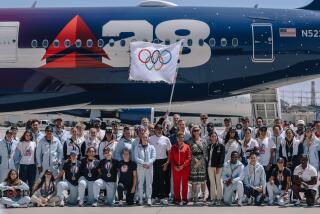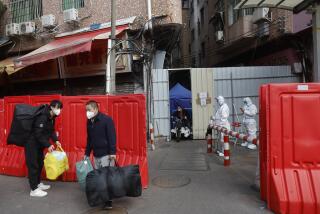China rolls out test of anti-smog plan
- Share via
BEIJING — Liu Ming, a 28-year-old sales executive, usually leaves his west Beijing home in his little red Toyota at 6:30 a.m. to avoid the worst of Beijing’s rush-hour traffic. Even so, his 22-mile cross-town commute usually takes about an hour.
On Friday, however, Liu was able to sleep in a little. The government had ordered his car off the street because it has a license plate ending with an even number, part of a four-day test aimed at bringing down air pollution and traffic congestion.
The test, which runs through Monday, is aimed at convincing international Olympic officials that the Chinese capital can clean up its skies by this time next year, when the Summer Games come to Beijing.
For Liu, it meant his trip to his job at a website for Chinese job seekers took a bit longer, nearly an hour and a half on the subway. But he was able to leave home at a more leisurely 9:30 a.m. Many businesses changed their hours to accommodate employees and customers.
That was not Liu’s main reason for supporting the car ban, however. It allowed him to do his part to alleviate smog, he said.
“It’s also good for my health,” he laughed sheepishly. “I’ve gained a few pounds by driving everywhere.”
According to government statistics, Beijing now has a bit more than 3 million registered vehicles, which pump out an estimated 1.3 million tons of pollutants every year. Local environmental officials cite this as the primary reason behind the city’s ever-worsening air quality and the persistent haze that hovers over the skyline.
In a country that was known just a decade ago as the “kingdom of bikes,” the number of cars hitting the road continues to skyrocket. The China Automotive Industry Assn. reported last week that nationwide, domestic auto sales through July had already topped 3.5 million this year, a 24% increase over the same period last year.
An estimated 1,000 new cars are added to Beijing’s roads daily, a rate that has raised concerns from Olympic officials that traffic and pollution, if not curbed, could force outdoor endurance sports, such as long-distance cycling races, to be postponed or rescheduled.
Hence the temporary car ban, which prohibits vehicles from the road on alternating days, depending on whether their license plates are odd- or even-numbered.
Friday was the first day off for even-numbered vehicles; today will be the first for odds.
Chinese authorities announced the test, which they boasted would take 1.3 million vehicles off the road, a day after Jacques Rogge, president of the International Olympic Committee, suggested last week that some events at the Beijing Games might have to be moved to cope with poor air quality.
International Olympic officials originally said the test program was to have lasted two weeks, which would have mirrored the two-week schedule of the Games, to be held Aug. 8-24, 2008.
But when city officials finally unveiled the ban, it had been pared down to four days, only two of which are weekdays.
“Owning a car is a status symbol in China,” said Luo Zhu, a researcher at the Road Engineering Research Center, which is affiliated with the Transport Ministry.
“It is not difficult to convince people if they are just doing this for a short time, but for a long time many problems will appear.”
Commuters said rush-hour traffic Friday was smoother than it had been at any time in recent memory, and subways and buses were a bit more crowded, even though more trains and buses were added to handle the increase in passengers. State-run media estimated that public transport ridership would rise to 8.4 million over the four-day ban, up from the normal 6.4 million.
Residents coped, with few complaints. Some carpooled; others, like Liu, left later for work; still others stayed home. Those caught flouting the ban faced modest fines, of about $13.
Meng Xiang, a Beijing taxi driver, said demand for his cab was heavy during rush hour -- but then again, he added, it was always heavy during rush hour.
A subway rider outside east Beijing’s Jianguomen station, daughter in tow, said that morning trains were crowded, but not much more than normal.
State media reported that pollution levels would be monitored by 30 air-quality stations spread across the city, though no results were announced by the end of the first day. To the naked eye, the ban appeared to have little effect. The haze appeared to be little better than earlier in the week, with nearby skyscrapers still barely visible through the smog.
Perhaps more remarkable was Beijing’s ability to pull off such a wide-ranging plan on such short notice, a testament to the continued ability of the government to mobilize masses of citizens with minimal effort.
Other Olympic hosts have tried similar car restrictions to combat pollution, but none have been on such a scale as in this city of 15 million.
Xia Xueluan, a professor in the sociology department at Peking University, said that only part of the credit should go to the government leaders. Overwhelming enthusiasm for the Olympics among the population also helped motivate drivers to make the sacrifice, he said.
“The Olympics is a big event, an event for the whole Chinese population,” Xia said, adding that he believed local commuters would adjust if a similar ban was imposed for the entire two weeks of the Games.
Some drivers were skeptical.
Meng, whipping through the capital’s streets in his blue-and-orange Honda taxi, said he thought there might be some resistance if the ban was extended any longer.
“I think it’s good for a short time, but for a long time it would be a problem,” Meng said, pausing before offering a possible solution:
“Maybe drivers can buy another car to get both an even-numbered license and an odd-numbered one.”
Gu Bo in The Times’ Beijing Bureau contributed to this report.
More to Read
Go beyond the scoreboard
Get the latest on L.A.'s teams in the daily Sports Report newsletter.
You may occasionally receive promotional content from the Los Angeles Times.






